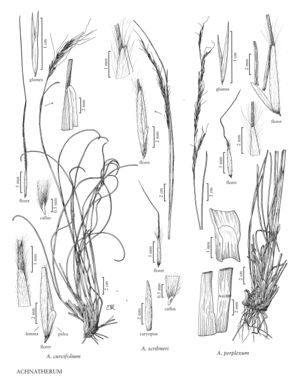Achnatherum curvifolium
Plants tightly cespitose, not rhizomatous. Culms 25-55 cm tall, 0.7-1 mm thick, glabrous; nodes 3. Basal sheaths usually puberulent, hairs 0.1-0.2 mm, sometimes densely tomentose at the base, brown to gray-brown when old; collars glabrous, sometimes with tufts of hair on the sides, hairs to 0.5 mm; ligules truncate, pubescent, hairs about 0.1; basal ligules about 0.3 mm, upper ligules to 0.6 mm; blades normally valvate to involute, about 0.5 mm in diameter, strongly arcuate, abaxial surfaces pubescent near the base, glabrous and smooth distally, adaxial surfaces densely hairy, hairs to 0.2 mm. Panicles 7-11 cm long, 1-2 cm wide; branches appressed to strongly ascending, longest branches 3-4 cm. Glumes subequal, 10-14 mm long, 0.7-0.9 mm wide; florets 6-8 mm long, 0.4-0.8 mm thick, fusiform, terete; calluses 1-1.5 mm, sharp; lemmas evenly hairy, hairs at midlength 0.3-1 mm, apical hairs 1-1.5 mm, apical lobes not developed; awns 22-38 mm, once-geniculate, first segment pubescent, hairs 1-2 mm, gradually decreasing in length distally; paleas 2-2.3 mm, 1/4-1/3 as long as the lemmas, glabrous; anthers about 3.5 mm, dehiscent, not penicillate. Caryopses about 4 mm, fusiform. 2n = 44.
Discussion
Achnatherum curvifolium grows on cliffs and in disturbed, rocky, limestone habitats. It is known from relatively few locations in the Flora region; it is more common in northern Mexico. It is most readily distinguished from other species of Achnatherum in the Flora region by its combination of curly leaves and hairy awns.
Selected References
None.
Lower Taxa
"decumbent" is not a number."thick" is not a number."prolonged" is not a number.
